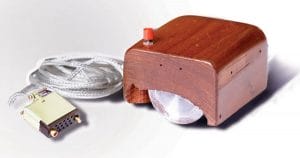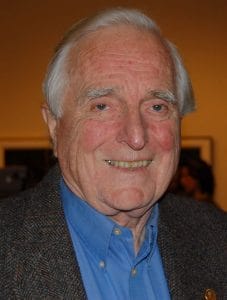An engineer, Engelbart was drafted in the middle of his studies to be a radar operator in World War II. While serving in the Philippines, he read As We May Think by Vannevar Bush, the head of the U.S. Office of Scientific Research and Development during the war. Bush expressed his concern about the direction of science — that it was moving more toward destruction (Bush was responsible for initiating the Manhattan Project, which developed the atomic bomb) rather than understanding the world and explaining it. Engelbart finished his degree after the war and went to work for the National Advisory Committee for Aeronautics — the predecessor to NASA — but in 1950 and newly married, he started thinking:
- He wanted to make the world a better place.
- He realized to do this, it required organized effort.
- Harnessing human intellect was the key to bring effective solutions.
- Large improvements in how intellect is harnessed is important, and
- Computers can be the vehicle for that improvement.
Engelbart thus got his Masters and Ph.D. in Electrical Engineering and then took a job at the Stanford Research Institute, and by 1962 had published his vision and how to achieve it: Augmenting Human Intellect: A Conceptual Framework. The Advanced Research Projects Agency saw promise and funded his work, and Engelbart founded the Augmentation Research Center at SRI. One of his visions was some sort of “working station” where workers could see information — which became the computer “workstation” for his “Online System”. To interact with that computer, Engelbart, with his experience with radar displays, thought a graphical interface would be useful, rather than typewriter-like computer terminal/printers. To work with the information on the display, in 1967 he invented an interactive device he called a mouse. “SRI patented the mouse, but they really had no idea of its value,” he said later. “Some years later it was learned that they had licensed it to Apple Computer for something like $40,000.”

In 1968, 13 years before the IBM PC and 15 years before the Apple Macintosh, all of his visions came together at the Fall Joint Computer Conference in San Francisco. At his presentation, which was later dubbed “The Mother of All Demos”, Engelbart demonstrated to more than 1,000 computer scientists what was coming out of his ARC lab: not just the video display and mouse, but also a chord keyboard, video conferencing, teleconferencing, hypertext, word processing, hypermedia, dynamic file linking, revision control, and even collaborative editing. (See video below.)
Engelbart’s Framework provided “for everything we have in the way computers work today,” said Apple co-founder Steve Wozniak. “What he did was absolutely brilliant and so far ahead of its time back then. He saw where the future was going to go.” But Engelbart never profited from his vision. “He was in the shadow of the people who would get credit for his ideas and make billions of dollars from them,” said Steven Levy, author of Insanely Great: The Life and Times of Macintosh, the Computer That Changed Everything. “He wanted to help people solve problems, and he saw the world as having very significant problems,” said Howard Rheingold, author of Tools for Thought: The History and Future of Mind-Expanding Technology. “That is not something you can get a patent on, start a company or make a fortune on. Bill Gates’ vision was a computer on every desk running Microsoft software. Doug had a much larger humanitarian vision.”

Engelbart’s funding ran out, his home fell into disrepair, his lab was sold in 1977, and he was mostly forgotten. But not by all: In December 1995, Engelbart was the first recipient of what would later become the Yuri Rubinsky Memorial Award. In 1997 he was awarded the Lemelson-MIT Prize, and the ACM Turing Award. To mark the 30th anniversary of Engelbart’s 1968 demo, the Stanford Silicon Valley Archives and the Institute for the Future hosted “Engelbart’s Unfinished Revolution” to honor the man and his ideas. Also in 1998, the ACM awarded him the CHI Lifetime Achievement Award. And in 2000, he received the National Medal of Technology and Innovation. Engelbart died in his sleep from kidney failure at his California home on July 2. He was 88.
